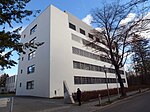AFN Berlin

AFN Berlin was a US military broadcast station located at Podbielskiallee 23 in Berlin-Dahlem. It started broadcasting at noon on August 4, 1945, with the Rhapsody in Blue by George Gershwin. The TV studio was located on Saargemünder Strasse, across from the Berlin Brigade Headquarters compound. During the Berlin Blockade AFN Berlin started broadcasting around the clock. After the building of the Berlin Wall AFN Berlin radio then stayed on the air 24 hours until July 1994. TV programming was normally from 15:00 to 01:00 weekdays and 12:00 to 01:00 on weekends during the mid 1970s. AFN Berlin had three stations: a medium-wave AM station at 1107 kHz an FM station at 87.85 MHz (adjusted to 87.9 MHz at a later stage, called 88FM) a TV station on UHF channel E29 (US channel 25) broadcasting in NTSC (thus requiring a multistandard set for German viewers) with a low-power transmitter limited to southwestern BerlinUntil November 23, 1978, the AM frequency was 935 kHz. Due to the agreements in the Geneva Frequency Plan the frequency was changed to 1107 kHz. On July 15, 1994, AFN Berlin broadcast a 3-hour special broadcast on both radio frequencies, which was transmitted live into 54 countries. Afterwards, seconds before 14:00, AFN Berlin ceased transmitting after playing a rendition of "The Star-Spangled Banner" performed by William Rivelli.
Excerpt from the Wikipedia article AFN Berlin (License: CC BY-SA 3.0, Authors, Images).AFN Berlin
Saargemünder Straße, Berlin Dahlem
Geographical coordinates (GPS) Address Nearby Places Show on map
Geographical coordinates (GPS)
| Latitude | Longitude |
|---|---|
| N 52.45 ° | E 13.275 ° |
Address
Saargemünder Straße 24
14195 Berlin, Dahlem
Germany
Open on Google Maps








